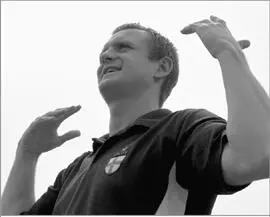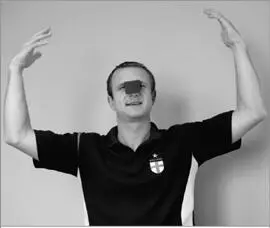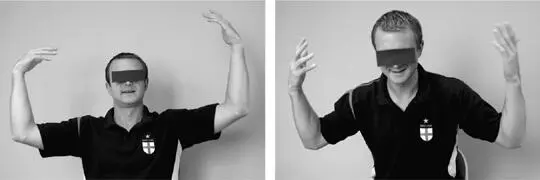To see which eye is dominant for distance, make a loose fist with a pencil-sized hole through the center, like a telescope. Hold your loose fist about a foot away from your face. (It could be closer for people who see poorly or farther for people who see sharply.) With both eyes at the same time, look at some distant point through the hole in your fist. Now close one eye and see if that point disappears. For example, if your stronger eye is your left eye, when you close the right eye, you will still see the object through your fist. When you close the left eye, you will not see the object, and vice versa. Then you’ll know which eye is stronger.
To see which eye is dominant for close distances, look at a page in this book, with its big and small letters. Look at the smallest letters you can see, and then close one eye at a time. Whichever eye can see the small letters better is your strong eye for nearby vision.
If you cannot figure out on your own which eye is stronger, you can go to an optometrist and ask for help.

Figure 2.3. Discovering the dominant eye.
But we ignore the periphery so we can focus on computers and paperwork all day without being distracted by our environment. We try to concentrate on the task at hand and can’t be distracted by the commotions around us. When we don’t notice the periphery, the strain on our central vision becomes much greater, which, in time, makes us use it poorly. This causes us to strain our central vision, decreasing its clarity and eventually losing it. The old adage that says use it or lose it holds true here. With time, we lose the connection between our brain, our optic nerve, and the rod cells of the periphery. Along with genetic tendencies, this can be a cause of glaucoma.
What we need to do right now is to exercise our periphery.
Periphery Exercise 1: Look into the Distance
Sit somewhere comfortable where you can see something in the distance that you enjoy looking at. As you look into the distance, start to wave your hands to the sides of your head to notify your eyes that a periphery exists. Don’t look at your hands waving; just look into the distance. Allow your eyes to recognize the movement of your hands.
Wave your hands in such a way that your fingers point toward you and your wrists are loose. Do this for a minute or two. As you do this, you should feel your eyes release their tension; this relaxation in your eyes is vitally important to healthy vision.

Figure 2.4. Will wakes up his periphery with a wave of his hands as he looks at the distance.
Periphery Exercise 2: The Small Pieces of Paper
Cut out a small piece of opaque paper (about one inch by two inches) and tape the paper horizontally on the bridge of your nose so that the wide parts are centered in front of your eyes. This will disrupt part of your vision.
Walk around in a familiar environment with this paper on your nose for a minute or two. Now sit down and wave your hands to the sides of your head like you did before. Stand up and sit down several times, moving your whole body up and down, as you wave your hands to the sides. As you do this, it reveals to your brain the existence of a moving periphery with which it normally does not connect.

Figure 2.5. Will uses the smallest piece of paper to block his central vision while activating his periphery.
In the past, people used to walk at night, sometimes in total darkness and sometimes with light from the stars and moon. Imagine how important it was for them to notice things moving in their periphery at night! For millions of years, our ancestors used to walk this way. Now we have the city lights at night, and our peripheral cells are hardly being used because they are mainly designed for night vision.
Waving our hands to our sides wakes up the peripheral cells because the rods of the retina respond to movement rather than to still images; conversely, the cones respond better to a still picture. These cones are mainly in the central part of the retina (the macula) and are used to look at details. An overwhelming number of the retina’s cells are the rods, which respond mainly to the impression of movement. When we exercise these rods, we take away a lot of stress from the overworked cones, and we make it easier for them to function more correctly. Instead of the brain forcing the eye to freeze and to strenuously see a picture, the brain will command the eye to look gently and easily in order to see the entire landscape better.

Figure 2.6. (a) Will blocks even more of his central vision. (b) As he waves, he leans forward and back to create more movement in his periphery.
Next, put a longer piece of paper (one inch by five inches) on the bridge of your nose and repeat this exercise. Then use a piece of paper that is one inch by seven inches. By blocking so much of your central vision, and even some of your peripheral vision, you will discover a periphery that you hardly ever use consciously. Now go back to the medium-sized paper and repeat the exercise. Then use the small piece of paper and repeat the exercise for a final time. You may find that the small piece now seems even smaller in your perception. That is because much of your brain that had been suppressed is now engaged in peripheral vision.
To finish, take the small paper off, stand, and do the long swing so your brain will absorb the exercise you have just performed.
Step 4: Sunning and Skying
Sunning
Surrendering to the sun briefly each day can make a huge difference in terms of our overall feeling of well-being.
Since the 1980s, physicians have warned us against the dangers of exposure to the sun. Now they understand the benefits of sunlight and recommend that we have some exposure to it daily. The sun is one of the best nurturers that nature has given us. It is important, however, to adapt your eyes to the strong light of the sun. Sunning is a great exercise for this purpose because it is relaxing to the eyes and can also help you with your sleep.
I once had a patient who complained about terrible insomnia. She had not slept for many nights and had a tremendous amount of tension. I taught her the sunning exercise and massaged her in the sun. After her first session, she went home and slept right through the night; after taking only three sessions at the school, she reported that she had slept much better. That was years ago. To this day, she practices the sunning technique and no longer experiences sleep deprivation.
Today, physicians suggest that we should not expose ourselves to the sun, except before 10 a.m. and after 5 p.m. In my opinion, we should sometimes expose ourselves to the sun even at midday. If you are sensitive to sunlight, you should start by practicing the sunning exercise early in the morning or near dusk, or for just five minutes at a time in the middle of the day.
To begin sunning, all you need to do is close your eyes and face the sun. Now move your head from side to side, rotating it from shoulder to shoulder. As you face the sun, the sphincter pupillae constrict the pupils. As you move your head away toward one shoulder, the radial dilator muscle dilates the pupil, even though your eyes are closed. Some people find it easy to move their head 180 degrees from shoulder to shoulder. If you find this full range of motion difficult, simply bring your opposite shoulder forward slightly; it will help you to move your head all the way toward the side and to compensate for the limited range of motion until you loosen up. The more you practice this exercise, the more your range of motion and flexibility will increase.
Читать дальше















